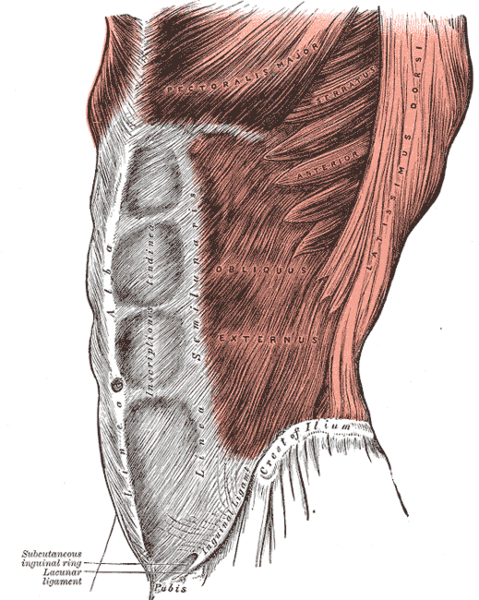The abdominal wall consists of four distinct muscles, the transverse abdominus, the internal obliques, the rectus abdominus, and the external obliques. These muscles form three distinct layers, with the rectus abdominus and external obliques on top. The transverse adbominus forms a kind of belt around the lower spine and the internal obliques stitch together up towards the ribs while the external obliques stitch together down from the serratus muscles to the top of the iliac crest.
The external obliques interlace with the intercostal muscles to support movement of the ribs and spine. They are most important for rotation of the thoracic spine and is what allows for stabilization while twisting and for support during flexion.
The insertion of the upper fibers occurs at the 5th through 9th ribs where they interlace with the serratus muscles and the 9th through 12th ribs interlacing with the latimus dorsi. The origin of the muscle is at the linea alba, the centerline of the abdomen and the front portion of the iliac crest and the upper part of the pubic tubercle. The external oblique is the largest of the three muscles on the outside of the abdomen.
The muscle fibers of the external oblique run inwards, towards one another, and down towards the iliac crest at the outside of the hips.  The muscle has eight muscular peaks for each of the eight ribs that it crosses over. The oblique runs down to the Iliac Crest where it inserts into the top of the hip plate and forms the inguinal ligament, which connects the top of the hip crest to the pubis bone at the bottom of the pelvis.
The muscle has eight muscular peaks for each of the eight ribs that it crosses over. The oblique runs down to the Iliac Crest where it inserts into the top of the hip plate and forms the inguinal ligament, which connects the top of the hip crest to the pubis bone at the bottom of the pelvis.
You activate the external oblique in side plank and stretch them in chaturangas, but there are enormous amounts of exercises to target the muscle. The next layer of abdominal muscles just underneath the external oblique is the internal oblique, which will be part 2. Check back soon to see part 2!

